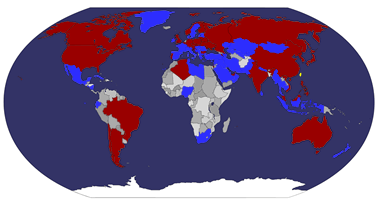
Catherine I (In Russian: Екатерина I Алексеевна) (born Marta Helena Skowrońska, Latvian: Marta Elena Skavronska, later Marfa Samuilovna Skavronskaya) (15 April [O.S. 5 April] 1684 – 17 May [O.S. 6 May] 1727), the second wife of Peter the Great, reigned as Empress of Russia from 1725 until her death.
The life of Catherine I was said by Voltaire to be nearly as extraordinary as Peter the Great himself. There are no documents that confirm the ascent of Catherine. The commonly accepted version is that Catherine was born in Ringen (Rõngu), in present-day Estonia. At the time this area was the Swedish province of Livonia. Originally named 'Marta Skowrońska', she was the daughter of Samuel Skowroński, later Samuil Skavronsky, a Latvian peasant of Polish origin, most likely a Catholic, and who was already a widower of one Dorothea Hann. Her mother has been listed on at least one site as Elisabeth Moritz, whom her father married at Jakobstadt in 1680. There is some speculation that her parents were runaway serfs. Some sources state her father was a gravedigger. Samuil and her mother died of plague around 1684 or 1685, leaving five children. She was taken by an aunt who sent her to be raised by Ernst Glück, the Lutheran pastor and educator who first translated the Bible into Latvian, in Marienburg. She was essentially a house servant. No effort was made to teach her to read and she remained illiterate throughout her life.
She was a very beautiful young girl, and there are accounts that Frau Glück became fearful that Marta would become involved with her son. At the age of seventeen, she was married off to a Swedish dragoon, Johan Cruse or Johann Rabbe, with whom she remained for eight days in 1702, at which point the Swedish troops were withdrawn from Marienburg. When Russian forces captured Marienburg the Pastor Glück offered and was taken to Moscow to work as a translator for Field Marshal Boris Sheremetev. There are unsubstantiated stories that Marta worked briefly in the laundry of the victorious regiment, and also that she was presented in her undergarments to the Brigadier General Adolf Rudolf Bauer to be his mistress. She definitely worked in the household of his superior, the Field Marshal Sheremetev. It is not known whether she was his mistress, or domestic servant.
She then became part of the household of Prince Aleksandr Menshikov, the best friend of Peter the Great. Anecdotal sources suggest that she was purchased by him. Whether the two of them were lovers is highly disputed, for Menshikov was engaged to Darya Arsenyeva, his future well-loved wife. It is clear that Menshikov and Marta formed a lifetime alliance, and it is possible that Menshikov who was quite jealous of Peter's attentions and knew his tastes, wanted to procure a mistress on whom he could rely. In any case, in 1703, while visiting Menshikov at his home, Peter met Marta, and shortly after, he took her as his own mistress. In 1705, she converted to Orthodoxy and changed her name to Yekaterina Alexeyevna. She and Darya accompanied Peter and Menshikov on their military excursions.
Catherine and Peter married secretly in 1707. They had nine children, two of whom survived into adulthood, Yelizaveta (1709) and Anna (born 1708). Peter had moved the capital to St Petersburg in 1703. While the city was being built he lived in a three-room log cabin with Catherine, where she did the cooking and caring for the children and he tended a garden as though they were an ordinary couple. The relationship was the most successful of Peter's life and a great number of letters exist demonstrating the strong affection between Catherine and Peter. As a person she was very strong, energetic, compassionate, charming and always cheerful. She was able to calm Peter in his frequent rages and was called in to attend him during his epileptic seizures.
Catherine continued to accompany Peter on his Pruth Campaign in 1711. There Catherine was said to have saved Peter and his Empire. Surrounded by overwhelming numbers of Turkish troops, Catherine suggested before surrendering, her jewels and those of the other women be used in an effort to bribe the Grand Vizier Baltaji into allowing a retreat. Baltaji allowed the retreat, whether motivated by a bribe or considerations of trade and diplomacy. In any case Peter credited Catherine and proceeded to marry her again (this time officially) at Saint Isaac's Cathedral in St. Petersburg on 9 February 1712. Catherine was Peter's second wife; he had previously married and divorced Eudoxia Lopukhina, who had borne him the Tsarevich Alexis Petrovich. Upon their wedding,she (Catherine) took the style of her husband and became Tsarina. When Peter elevated the Russian Tsardom to Empire,Catherine became Empress (Imperatrica). The Order of Saint Catherine was instituted by her husband on the occasion of their wedding.
Upon Peter's death, Catherine found her four siblings, Christine, Anna, Karl and Friederich/Theodor, gave them the newly created titles of Count and Countess, and brought them to Russia. Christine Skowrońska, renamed Christina Samuilovna Skavronskaya (1687 – 14 April 1729), married Simon-Heinrich N (1672-1728) and their issue were Counts Hendrikov; Anna Skowrońska, renamed Anna Samuilovna Skavronskaya, married one Michael-Joachim N and their issue were Counts Efimovsky; Karl Skowroński, renamed Karel Samuilovich Skavronsky, was created a Count of the Russian Empire on 5 January 1727 and made a Chamberlain of the Imperial Court, married to Maria Ivanovna, a Russian woman, by whom he had issue extinct in male line in 1793; Friedrich/Theodor Skowroński, renamed Feodor Samuilovich Skavronsky, was created a Count of the Russian Empire on 5 January 1727 and married twice to N, a Lithuanian woman, and to Ekaterina Rodionovna Saburova, without issue of any of them.
In 1724 Catherine was officially named co-ruler.
The year before his death, Peter and Catherine had an estrangement over her support of William Mons (brother of Peter's former mistress and secretary to Catherine) and his sister Matrena, one of Catherine's ladies-in-waiting. Peter had fought his entire life a somewhat hopeless battle to clear up corruption in Russia. Catherine had a great deal of influence on who could gain access to her husband. William Mons and his sister had begun selling their influence to those who wanted access to Catherine and, through her, to Peter. Apparently this had been overlooked by Catherine, who was fond of both. Peter found out and had Mons executed and his sister exiled. He and Catherine did not speak for several months. Rumors flew that she and Mons had had an affair, but there is no evidence for this.
Peter died (28 January 1725 Old Style) without naming a successor. Catherine represented the interests of the "new men", commoners who had been brought to positions of great power by Peter based on competence. A change in government was likely to favor the entrenched aristocrats. For that reason during a meeting of a council to decide on a successor a coup was arranged by Menshikov and others in which the guards regiments with whom Catherine was very popular proclaimed her the ruler of Russia, giving her the title of Empress. Supporting evidence was "produced" from Peter's secretary Makarov and the Bishop of Pskov, both "new men" with motivation to see Catherine take over. The real power, however, lay with Menshikov, Peter Tolstoy and with other members of the Supreme Privy Council.
Catherine was the first woman to rule Imperial Russia, opening the legal path for a century almost entirely dominated by women, including her daughter Elizabeth and Catherine the Great, all of whom continued Peter the Great's policies in modernizing Russia. She was said to be a just and fair ruler.
The Supreme Privy Council concentrated power in the hands of one party, and thus was an executive innovation. In foreign affairs, Russia joined the Austro-Spanish league to reluctantly defend the interests of Catherine's son-in-law, the Duke of Holstein, against England.
Catherine gave her name to Catherinehof near St. Petersburg, and built the first bridges in the new capital. She was also the first royal owner of the Tsarskoye Selo estate, where the Catherine Palace still bears her name.
In general, Catherine's policies were reasonable and cautious. The story of her humble origins was considered by later generations of tsars to be a state secret.
She died just two years after Peter, at age 43, in St. Petersburg, where she was buried at St. Peter and St. Paul Fortress. It is not known what caused her early demise.
Catherine I (Екатерина I), de son vrai nom Marthe Skavronskaïa (née le 15 avril 1684 en Livonie et décédée le 17 mai 1727), est impératrice de Russie de 1725 à 1727. Elle épouse l'empereur Pierre Ier en 1707.
Née de parents pauvres, qui moururent atteints de la peste, elle fut envoyée par sa tante en tant que servante chez le pasteur Johann Ernst Glück (en), traducteur de la Bible en letton. Analphabète, elle venait d'épouser à 17 ans un simple soldat suédois lorsqu'elle fut réduite en captivité après la prise de Marienbourg. D'une beauté remarquable, elle plut au prince Alexandre Menchikov, et bientôt après à Pierre le Grand lui-même. En 1711, elle accompagna le tsar dans sa campagne contre les Turcs, et lui rendit le plus important service en traitant avec les ennemis qui le tenaient enfermé sur les bords du Prout : elle acheta au prix de ses pierreries la retraite du grand vizir. Le tsar l'épousa après en avoir eu plusieurs enfants ; en 1724 il la fit couronner solennellement impératrice. Après la mort du tsar (1725), elle fut reconnue souveraine de toutes les Russies puis laissa Menchikov prendre une grande influence.









.jpg)























 taiwan
taiwan  cover or postcard
cover or postcard  FDC
FDC 






























































































No comments:
Post a Comment